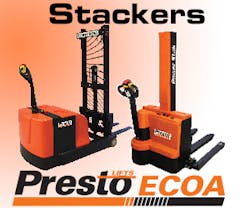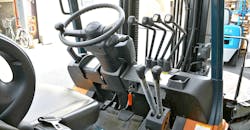Walk or Ride? Three Advantages of Moving Pallets with Hand Carts
Sometimes using a forklift for your pallet moving operation is like taking a bazooka to a knife fight. In many instances, a powered or manual hand truck will do.
These cases are sometimes obvious, and other times not so much, so we talked to Rick daSilva, national sales manager for Presto Lifts, to help us figure out what factors to consider when deciding to deploy a forklift or a walk behind hand truck, such as one of his company’s Stacker models. These powered and manual "walkies" are available in 150 models and have been in use for 70 years.
Safety
You are probably aware that forklift accidents are the number one risk in warehouse operations. In all industries, these account for around 100 deaths and 95,000 injuries every year, according to the Occupational Safety and Health Administration.
They account for 1% of all accidents, but 10% of all physical injuries, notes Michael Reddon of The MHEDA Journal.
The majority of fatalities stem from forklift turnovers, so an obvious advantage of pushing a cart as opposed to sitting in a vehicle is not going down with the ship, so to speak, if it slips off a loading dock or tips due to an unbalanced load. You can just step away.
OSHA also argues that hand trucks are inherently safer: “A sit-down, counterbalanced high-lift rider truck is more likely than a motorized hand truck to be involved in a falling load accident because the sit-down rider truck can lift a load much higher than a hand truck.”
Obstructed vision also occurs with forklifts.
“When you’re sitting in a forklift and feeding palletizing operation, there’s not great visibility,” daSilva says. “We offer Stackers with a narrow mast and offset handle for improved visibility in the work cell, and an unobstructed view of pallets and other workers.”
It should be noted that you can equip your forklift with a camera to provide a pallet POV improve that view, though ask yourself this: Would you rather watch a football game on the 50-yard line, or on a 15-in. TV? And remember, in this scenario, instead of missing an awesome block made downfield, you don’t see ol’ George, who just bent over to pick up his screwdriver.
So when deciding if what equipment to use in your palletizing operation, you should always at least consider hand trucks.
Maneuverability
Hand trucks don’t have the load capacity of forklifts, but they do benefit from more intuitive steering. In a grocery store, are you less likely to hit that 10-ft tall display of soup cans with a cart or one of those Rascal Scooter-type motorized vehicles, which require you to steer and use accelerator and brake controls?
Now look at how complicated a forklift control setup is:
In a factory, a forklift may have to veer out of the way of a crucial multi-million dollar piece of machinery or rolled material, not soup can displays.
“It’s a lot better to utilize a walk behind for work positioning,” daSilva says.
Forklifts, at maximum, can only travel 8 mph or 3 mph around people, but even at that speed, one of these 4-ton vehicle’s steel tusks can puncture your machinery and shut down your operation.
DaSilva says the certain powered Stackers have built-in features to provide even more control.
“PPS units all feature Turtle Speed, cutting speed by 50% at the handle,” he says. “They use a transistor-type variable speed, so the Turtle button helps in cases when workers gets a little overzealous and cranks up the speed.”
Click here to look at Presto Lifts Selection Guide.
Economics
Even if the well-being of your employees matches that of C. Montgomery Burns, the cost advantage of hand trucks is hard to pass up.
Pallet jacks can cost less than $500 and powered hand trucks less than $3,000. DaSilva says Stackers comparable to forklifts cost a little over $6,000, or half the price.
If your facility loads pallets weighing less than a ton and stack relatively low, you probably know that, and this article is preaching to the choir.
But most warehouses are more sophisticated than that and require moving materials heavier and higher than a hand truck can go. They may use a fleet of forklifts, without any injury or accident to speak of.
DaSilva says assisting this fleet with hand trucks can still maximize efficiency.
“How do they work together?” daSilva asks. “The key is to utilize the lift truck for the right applications.”
He advises not to use forklifts for work positioning and lighter loads because a tool such as the Stacker can do the same job.
“Forklifts may have a 4,000 or 6,000-lb. capacity but are being used to feed 1,500 or 2,000-lb. loads,” he says.
That means the forklift that would be doing this job could be deployed to another task, or just see less use, and therefore reduce the frequency of preventative maintenance done on it. This would reduce operational cost, and of course, any workman’s compensation payout due to an accident.
If you still have doubts, daSilva has one last way to help you decide when to use a hand truck:
“Anywhere you’re maneuvering in tight spaces, anywhere forklift traffic creates an unsafe environment, a powered pallet truck or stacker should be your first choice."
For more information, please visit www.prestolifts.com.















